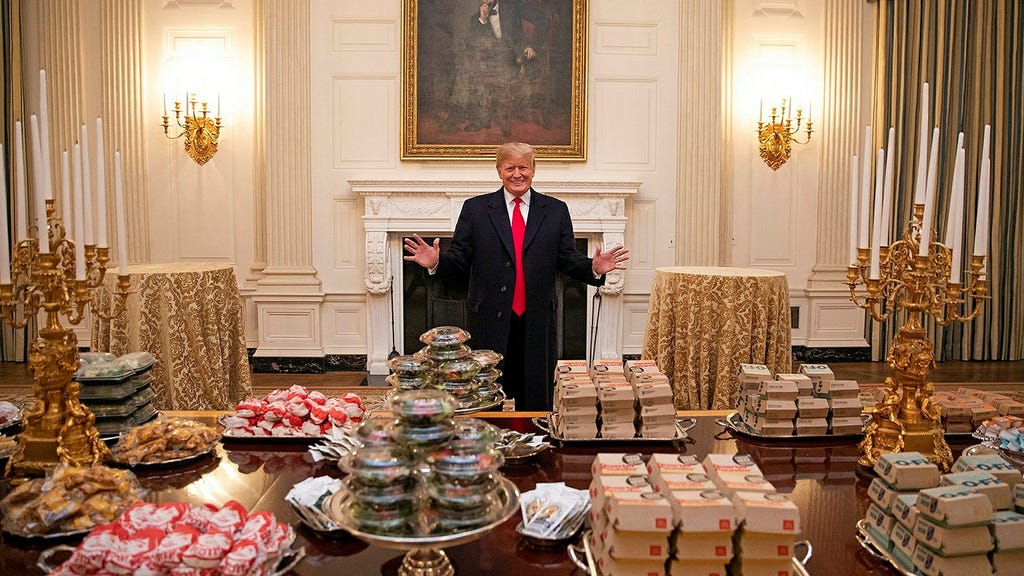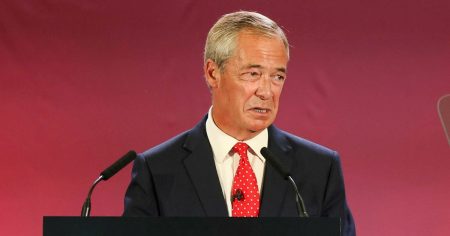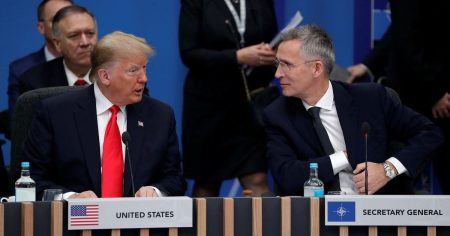Donald Trump’s well-documented affinity for fast food, particularly McDonald’s, has been a recurring theme throughout his public life, both during his presidency and beyond. This preference, often exemplified by orders such as ”Two Big Macs, two Filet-O-Fish sandwiches, and a chocolate milkshake,” has sparked considerable curiosity and analysis, prompting discussions ranging from his dietary habits to potential symbolic interpretations. While the precise motivations behind this culinary inclination remain within Trump’s personal domain, several factors might contribute to this enduring fast-food fascination. These potential influences encompass everything from ingrained habits and perceived convenience to psychological comfort and even strategic branding.
One prominent theory centers on the notion of familiarity and comfort. Fast food chains like McDonald’s represent a consistent and predictable experience, offering standardized menus and tastes regardless of location. For individuals with demanding schedules and constant travel, this predictability can provide a sense of stability and normalcy amidst a chaotic environment. Trump’s frequent travels and demanding lifestyle, both as a businessman and as president, might have led him to seek out the reliable comfort and familiarity of these fast-food staples. This preference for the predictable could also extend to the taste itself, offering a nostalgic connection to simpler times and familiar flavors.
Another contributing factor could be the association of fast food, particularly McDonald’s, with a certain image of Americana and working-class values. Trump, despite his wealth and privileged background, has often sought to cultivate an image of connection with the everyday American. His embrace of fast food could be seen as a strategic attempt to foster this relatable persona, projecting an image of a man of the people who enjoys the same simple pleasures as the average citizen. This populist appeal resonates with a specific demographic and reinforces the narrative of a leader who understands and shares the common experiences of the working class.
Beyond the symbolic interpretations, practical considerations might also play a role in Trump’s fast-food choices. The speed and convenience of fast food are undeniable, making it a practical option for individuals with limited time or those constantly on the move. The readily available nature of these meals eliminates the need for elaborate meal planning or extended dining experiences, allowing for quick consumption amidst a busy schedule. This aspect of expediency likely appeals to someone like Trump, whose demanding lifestyle leaves little room for leisurely meals.
Furthermore, psychological factors related to comfort and sensory experience could contribute to this culinary preference. The high fat, salt, and sugar content typical of fast food often triggers the release of dopamine, a neurotransmitter associated with pleasure and reward. This dopamine rush can create a sense of satisfaction and comfort, particularly during times of stress or pressure. Given the high-stakes nature of Trump’s professional life, the comforting effect of these foods might offer a temporary reprieve from the demands of his position.
Finally, it’s worth considering the role of personal taste and ingrained habits. Food preferences are often developed early in life and can remain relatively consistent throughout adulthood. If Trump developed a fondness for fast food during his youth, this preference might have simply persisted throughout his life, becoming a deeply ingrained habit. While various factors might contribute to his culinary inclinations, ultimately, personal taste remains a significant influence on dietary choices.
In conclusion, Donald Trump’s well-documented preference for fast food, often exemplified by orders like ”Two Big Macs, two Filet-O-Fish sandwiches, and a chocolate milkshake,” likely stems from a confluence of factors. From the comfort of familiarity and the association with Americana to the practical aspects of convenience and the potential psychological comfort derived from these foods, several elements might contribute to this enduring culinary inclination. While the precise motivations remain within Trump’s personal realm, exploring these potential contributing factors offers insights into the complexities of individual dietary choices and the various influences that shape our culinary preferences. The seemingly simple act of ordering fast food can, in fact, be a complex interplay of personal taste, cultural associations, psychological comfort, and practical considerations. While some might dismiss it as a mere dietary quirk, a closer examination reveals a multifaceted phenomenon shaped by a confluence of influences.
The fact that Trump, a figure who has access to some of the finest culinary experiences in the world, consistently chooses fast food over more elaborate options further underscores the significance of these contributing factors. This preference, despite his wealth and access to gourmet cuisine, suggests that more than just convenience or affordability is at play. It points to a deeper connection with these foods, whether rooted in nostalgia, comfort, symbolic associations, or a combination thereof. This unwavering preference, despite his position and resources, reinforces the idea that food choices are often driven by factors beyond simple nutritional value or culinary sophistication.
The public fascination with Trump’s fast-food habits also speaks to the broader cultural significance of these culinary choices. In a world increasingly obsessed with healthy eating and mindful consumption, Trump’s unapologetic embrace of fast food presents a stark contrast. This divergence from prevailing dietary trends further fuels public interest and adds another layer to the ongoing conversation surrounding his persona and public image. His open enjoyment of these foods, often perceived as unhealthy and indulgent, challenges conventional dietary wisdom and adds to the intrigue surrounding his public persona.
Furthermore, the specific items he chooses, such as the Big Mac and Filet-O-Fish, have become almost symbolic of his dietary preferences. These menu items, easily recognized and widely available, reinforce the image of a man who enjoys simple pleasures and readily identifiable brands. This association with specific fast-food items further solidifies the connection between Trump and this culinary realm, contributing to the ongoing narrative surrounding his dietary choices.
Ultimately, the reasons behind Donald Trump’s enduring fondness for fast food remain subject to speculation and interpretation. However, by considering the various factors potentially at play, we can gain a deeper understanding of the complexities that influence our dietary choices and the symbolic meaning we attach to specific foods. From the comfort of familiarity and the allure of convenience to the potential psychological benefits and the ingrained nature of personal taste, a multitude of influences shapes our culinary preferences. While the specific motivations behind Trump’s fast-food affinity may remain elusive, exploring these potential contributing factors offers valuable insights into the broader dynamics of food choices and the multifaceted influences that shape our relationship with what we eat. The seemingly simple act of ordering ”Two Big Macs, two Filet-O-Fish sandwiches, and a chocolate milkshake” can, in fact, be a window into a complex interplay of personal, cultural, and psychological elements.














